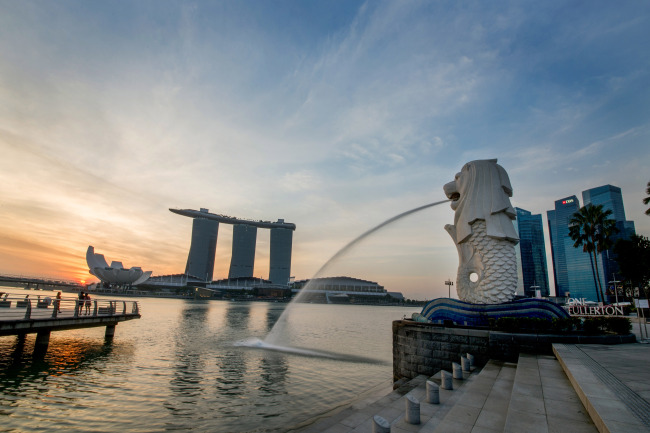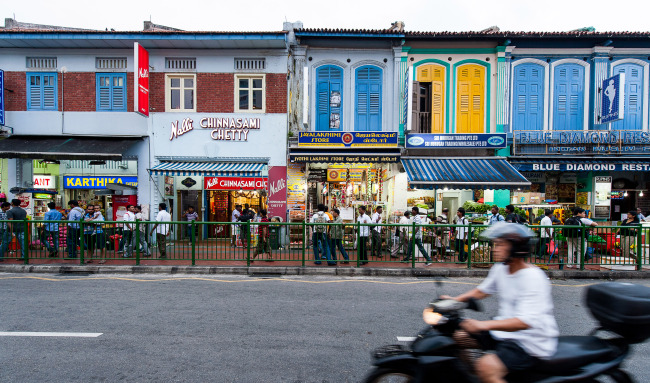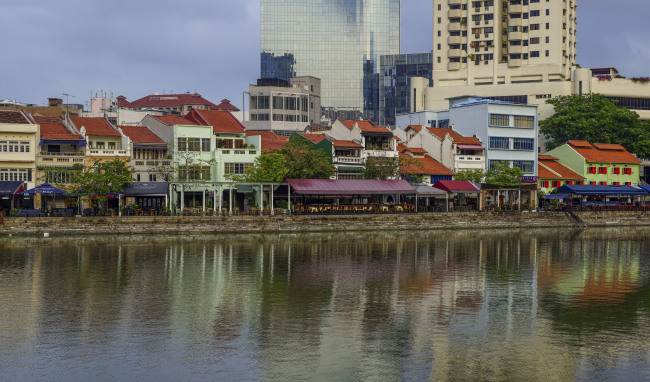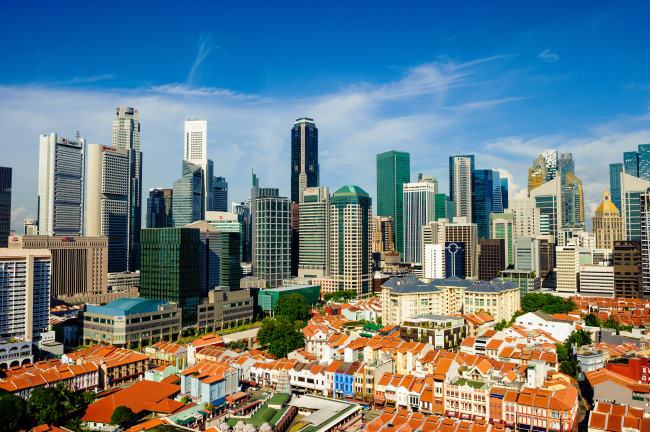[US-NK Summit] Singapore: multicultural ‘little red dot’ with S. Korea, NK ties
How much do S. Koreans know about the island nation?
By Cheryl Faith WeePublished : June 10, 2018 - 16:43
The outcome of the US-North Korea summit on June 12 remains to be seen, but Singaporeans have offered their own cheeky take on the matter with memes that poke fun at the two leaders.
US President Donald Trump and North Korean leader Kim Jong-un hobnob in the rooftop infinity pool of Marina Bay Sands against a backdrop of the Singapore skyline. They pose awkwardly for a picture together near a statue of the Merlion -- a creature with the head of a lion and body of a fish.
Such edited images have been making the rounds on social media since the announcement the country would host the summit.
US President Donald Trump and North Korean leader Kim Jong-un hobnob in the rooftop infinity pool of Marina Bay Sands against a backdrop of the Singapore skyline. They pose awkwardly for a picture together near a statue of the Merlion -- a creature with the head of a lion and body of a fish.
Such edited images have been making the rounds on social media since the announcement the country would host the summit.

Singapore’s residents are no strangers to world leaders descending upon the city-state for significant events, including the first meeting between Chinese President Xi Jinping and Taiwanese President Ma Ying-jeou in 2015.
On the other hand, outsiders -- including Trump -- might not be as familiar with the island nation.
In 2017, Trump confused Singapore’s Prime Minister Lee Hsien Loong with Indonesian President Joko “Jokowi” Widodo in a caption on his Instagram account, though the mistake was quickly corrected.
Despite the blunder, Lee has welcomed the US-North Korea summit.
With South Korea and other countries highly anticipating the event, Singapore has suddenly found itself on the radar of onlookers worldwide.
But how much do people on this side of Asia know about the city-state? The Korea Herald has put together a list of 10 things that South Koreans may not have known about the country.
1. Little red dot
Singapore is so small that it is often identified on maps with just a red dot. In the late 1990s an Indonesian politician described the nation as a “little red dot,” referring to its small size in comparison to his own country. The phrase has since become often used in media.
Located near the southern tip of Peninsular Malaysia, Singapore’s total land area is around 720 square kilometers -- some 115 square kilometers bigger than Seoul -- including the main island and 62 other smaller islands considered part of its territory.
2. Winter in Singapore?
As a Singaporean living in Seoul, this reporter has been asked by South Koreans whether Singapore experiences winter. The answer is no -- not unless you consider January this year when an unusual cold spell of around 21 degrees Celsius sent a handful of Singaporeans reaching for their winter gear.
Temperatures are usually between 23 and 33 C all year round. Situated near the equator, the country has two monsoon seasons that bring moderate to heavy rainfall, from December to early March and June to September, according to the Meteorological Service Singapore.

3. Cultural hodgepodge
Whether strolling along the streets or taking the subway, it is easy to spot people of different races in Singapore.
Ethnic Chinese make up around three-quarters of the citizen population, with the remainder consisting of Malays (13 percent), Indians, (9 percent) and others such as Caucasians, according to government statistics.
The diversity can be traced back to the 1800s, when migrants from China, India and the Malay Archipelago began to come in droves to the island after the British established a trading post. Ethnic enclaves such as Chinatown, Little India and Kampong Glam still exist.
4. Former British colony
Singapore became a British crown colony in 1867 as part of a group of British territories in Southeast Asia. It was occupied by the Japanese from 1942 to 1945 but came back under British control after World War II. It became a self-governing state in 1959 and separated from Malaysia to become an independent state in 1965.
Buildings dating back to the colonial period remain, though they now mostly house museums, restaurants and hotels. For instance, there is the Fullerton Hotel Singapore building, named after the first governor of the Straits Settlements.
5. English or Singlish
Although English is the main language used in schools and at workplaces, most Singaporeans are bilingual, as the Education Ministry requires students to learn an additional language, usually either Chinese, Malay or Tamil, depending on the ethnic group.
Influenced by the mix of languages, Singaporeans have come up with their own form of colloquial English, referred to as Singlish, which borrows words from the three languages as well as dialects. A single sentence spoken by a Singaporean could be peppered with words from different languages.
Critics have denounced Singlish as “bad English,” but many Singaporeans say it is an intrinsic part of their identity.

6. Drinking rules
Enjoying a couple of drinks next to the Han River is a popular activity in Seoul, but be careful doing the same in Singapore -- it is against the law to consume alcohol in public places such as parks and beaches between 10:30 p.m. and 7 a.m. Retailers are also not allowed to sell takeaway alcohol during that duration.
However, people are allowed to drink at pubs, restaurants, coffee shops and other licensed premises during that time frame. Those caught drinking illegally could be fined up to 1,000 Singapore dollars ($749). Repeat offenders could be fined up to SG$2000 and jailed up to three months. There are stricter rules in the Geylang and Little India areas.
7. Swept up by Korean Wave
Hallyu has swept across the country in the past decade, from K-beauty cosmetics to K-pop to Korean food invading the daily lives of Singaporeans. Many Korean celebrities have held performances or fan meetings in the city-state, including EXO, BTS and actor Song Joong-ki.
In a nation obsessed with food, Korean restaurants have sprouted up in areas such as Tanjong Pagar in the central business district, where you can find Korean-style fried chicken.
Korean instant noodles and snacks are also widely sold at convenience stores and supermarkets in the country.
8. NK-Singapore links
The North Korean Embassy in Singapore sits on the 15th floor of the High Street Center building that overlooks the winding Singapore River, just a stone’s throw from the Parliament of Singapore.
Diplomatic relations between the two countries date back to the mid-1970s. The embassy currently has eight representatives and spouses registered with Singapore’s Ministry of Foreign Affairs, according to a Bloomberg report. Until 2016, North Koreans were even allowed to visit the country visa-free.
Singaporeans are able to visit North Korea with visas, though the Ministry of Foreign Affairs issued an advisory against traveling there in 2017.
Some have done more than just tour the country, leaving a mark in North Korea. For instance, the first fast-food restaurant in Pyongyang was opened by Singaporeans in 2009, according to the Straits Times newspaper.

9. Top attractions for S. Koreans
Koreans flock to Singapore’s Chinatown, integrated resorts and Merlion Park -- the top three most popular attractions among Korean tourists, according to a 2015 report by the Singapore Tourism Board, which cited national pride as a possible reason for the popularity of the Marina Bay Sands resort near the central business district. The hotel was built by South Korean construction company SsangYong Engineering & Construction.
Singapore saw more than 630,000 visitor arrivals from South Korea in 2017, up 11 percent from the previous year, showed statistics from the tourism board.
10. Tall buildings, no mountains
Singapore has no mountains to boast of. Bukit Timah Hill stands highest at just 164 meters. On the other hand, the country has no shortage of skyscrapers, with the tallest being the 64-story, 290-meter Tanjong Pagar Center in the central business district. Furthermore, more than 80 percent of the population live in public housing, which mostly comprises high-rise buildings.
By Cheryl Faith Wee (cherylw@heraldcorp.com)



![[Exclusive] Korean military set to ban iPhones over 'security' concerns](http://res.heraldm.com/phpwas/restmb_idxmake.php?idx=644&simg=/content/image/2024/04/23/20240423050599_0.jpg&u=20240423183955)

![[Graphic News] 77% of young Koreans still financially dependent](http://res.heraldm.com/phpwas/restmb_idxmake.php?idx=644&simg=/content/image/2024/04/22/20240422050762_0.gif&u=)



![[Pressure points] Leggings in public: Fashion statement or social faux pas?](http://res.heraldm.com/phpwas/restmb_idxmake.php?idx=644&simg=/content/image/2024/04/23/20240423050669_0.jpg&u=)









